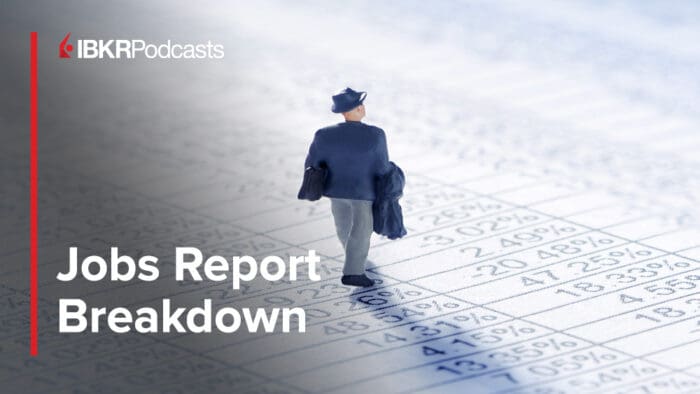Andrew Wilkinson and Jose Torres sit down to talk about last Friday’s Jobs report and the painful de-inversion that occurred across the 2- and 10-year Treasury maturities. Historically, the development has been met with an economic downturn and traders are certainly taking notice with risk assets off their recent highs. Still, the weaker-than-expected employment figures carried some strength under the hood, namely an increasing labor force, slipping joblessness and accelerating wages which is keeping the Fed on track for 25 in September rather than 50.
Summary – IBKR Podcasts Ep. 188
The following is a summary of a live audio recording and may contain errors in spelling or grammar. Although IBKR has edited for clarity no material changes have been made.
Andrew Wilkinson
Welcome to this week’s podcast from Interactive Brokers. Joining me to discuss the market impact of last week’s employment report is Interactive Brokers Senior economist, Jose Torres. Welcome. How are
Jose Torres
Hello everyone. Andrew, great to see you doing great. How are you?
Andrew Wilkinson
Good, thank you. Good, thank you. Let’s get straight into last Friday’s August payroll report, which fell short of consensus again. Tell us your thoughts on the report and what it tells us about the economy, Jose.
Jose Torres
Sure. So the report was weaker than expected, but there was actually some strength under the hood. You saw the labor force expand by 120,000. The unemployment rate actually ticked down from 4.3% to 4.2%, which is a sign of strength because usually when the labor force expands, that’s usually upward pressure on the unemployment rate.
So that’s a good dynamic that we saw labor force increase, unemployment rate decline. Wage pressures also picked up 0.4% month over month. That was pretty good. Year over year came in above expectations by 10 bps. That was also favorable.
But against that backdrop, it wasn’t great for inflation monetary policy doves that were looking for 50 bps, right?
Because when you have that kind of pressure, and you still have jobs growing well above 100,000, then it’s kind of hard to tell the Fed to start cutting imminently and aggressively. Imminently is one thing, but not aggressively. And really, the walk down the monetary policy stairs is either going to be a slow and controlled walk vertically, or a horizontal roll down to lower stories, right? And that’s more of like the panic cuts, 50 basis points, 100 basis points, where the vertical slow walk is more “25 at a time”.
Andrew Wilkinson
So, Jerome Powell has already told us that next week at the September FOMC meeting on the 17th and 18th that there will be an interest rate cut, and we heard it again from New York Fed Chief John Williams last week. Do you think the 142,000 payroll gain makes a 50 basis point cut more likely now?
Jose Torres
No, because the unemployment rate came down, wage pressures were strong, inflation, you know, it’s cooperating very well, particularly with goods and commodities.
Look at automobiles.
Andrew, they’ve gone down every month this year, every single month. How long can we count on that? When interest rates start to come down, you’re going to start to see at the automobile dealerships, folks are going to start going in there.
The realtor offices, they’re going to start becoming busier, right? So those are some considerations as we start to bring rates down, what kind of activity re ignition is going to occur against that backdrop. So right now the Fed is fine doing 25, a series of 25 is okay. Again, I know we’re used to seeing 200, 000 jobs added, 300, 000 jobs added, but 140, 150 is perfectly healthy.
However, some of the downside of the report, again, we see a non-cyclical tilt, right? We see half of the jobs added roughly are coming from areas that are not sensitive to the economic activity. Healthcare, government, education, right? Private sector, more cyclical areas like manufacturing, professional business services, retail, they’re doing a little weaker.
Finally, construction, leisure and hospitality. Those have been two strong sources of strength. Construction, we’re under built in this country. We have substantial immigration flows and folks are really clamoring for the American dream because affordability is becoming out of reach, right? So those are some dynamics that are occurring there in the real estate market.
Andrew Wilkinson
So, let’s have a think about the bond market’s reaction to the employment report. We’ve been living with what we call an inverted yield curve for several years now. and last week, maybe the week before, we flipped back to give a positive yield curve. Explain to the audience what you’re seeing in the 2s 10s area of the curve, Jose, and why it matters.
Jose Torres
Absolutely. Yeah. So we saw a de-inversion and we’ve been seeing brief stints of de-inversion, where the ten year goes over the two year, but then it immediately inverts again. But Jobs Friday really unlocked a more substantial and significant de inversion, where the ten year went above the two year by three to four basis points, rather than just half a one or one, and then going back.
And it’s been sustained. Even today, Monday, September 9th, we’re still seeing that positively sloped yield curve, right? Historically, that’s what you see, right? When you’re lending money in normal conditions, you expect a lower rate of interest if you’re lending over the short term. But it just so happens that sometimes when the Fed needs to tighten significantly, the short end of the curve elevates to altitudes much higher than the long end of the curve.
Now, when we look at previous downturns, typically, they start when the yield curve becomes positively sloped again, and it also coincides with a powerful risk off signal in markets. We saw that risk off signal back in early August on the Japanese Yen carry trade day. We saw the twos and tens meet. And of course, there were other much more significant events happening that day that made risk markets decline in value significantly, right?
That wasn’t the primary theme, but we see that when that happens, it is a powerful risk off signal, every recession, when we’ve gone from being inverted for such a long time, call it a year or more, and then gone back to a normally sloping yield curve, positively sloping, we’ve gone into recession.
And I’d invite the audience to my chart from Friday, September 6th commentary, where you can see that historical reference.
Andrew Wilkinson
Very good. Now that’s on Traders Insight. You’ll see that there, folks.
What else is the FOMC or what are the voters on the FOMC taking with them into the meeting? We’ve got consumer prices out this week as well, Jose. What’s that significance have on the outcome?
Jose Torres
I mean, we’re not seeing inflationary pressures build at this juncture, right? They’re kind of stable. They’re kind of flat. Inflation is cooperating. The main focus these days is can the Fed lower rates and not bring price pressures back again to levels that are inconsistent with its 2% target?
And that’s a very tricky part of the cycle. And that’s what folks are really going to be focused on. Do they want to cut too fast and risk inflation coming back, right? Do they want to cut too slow and risk that the economy falls into a slowdown? And that’s really ultimately where we talk about the slow and controlled vertical walk down the monetary policy stairs, or a more emergency, quick, and volatile horizontal roll down the stairs, right?
And that’s really where we are in the cycle. Investors are nervous. Earnings expectations for next year are buoyant. They’re up in the 10% range. Plus or minus 2%, depending on who you ask for the most part. And if you’re going, if you think that we have some economic turbulence ahead, then how can you make double digit earnings growth off of already strong numbers this year?
Finally, With Harris and Trump becoming the next president in 2025, one or the other, from an earnings perspective and from an investing landscape, right, what is there to look forward to into 2025? And a lot of investors are asking themselves this when they look at equity prices at really lofty nosebleed level valuations, right?
What is there to look forward to? So I think upcoming earnings reports will be huge. As well as incoming economic data. For the market bulls, what they’d like to see, they’d like to see inflation right here with the two hand on the low twos. 2.4, 2.3, 2.2. With GDP above 1%, 1.5%. That’s what market bulls want to see.
Bears, on the other hand, they want to see inflation start to pick back up again. They want to see inflation get to 3%, 3.5%…, and they want to see GDP start to maybe get negative because the Fed can’t cut as fast as market participants would like.
Andrew Wilkinson
Perfect. Thank you very much, Jose Torres, Senior Economist for Interactive Brokers. And to the audience, thank you for joining us today. And look out for more episodes at IBKR Podcasts or from wherever you download your podcasts from.
Thanks, Jose.
Jose Torres
Thank you very much. Have a great day, everyone.
Disclosure: Interactive Brokers
The analysis in this material is provided for information only and is not and should not be construed as an offer to sell or the solicitation of an offer to buy any security. To the extent that this material discusses general market activity, industry or sector trends or other broad-based economic or political conditions, it should not be construed as research or investment advice. To the extent that it includes references to specific securities, commodities, currencies, or other instruments, those references do not constitute a recommendation by IBKR to buy, sell or hold such investments. This material does not and is not intended to take into account the particular financial conditions, investment objectives or requirements of individual customers. Before acting on this material, you should consider whether it is suitable for your particular circumstances and, as necessary, seek professional advice.
The views and opinions expressed herein are those of the author and do not necessarily reflect the views of Interactive Brokers, its affiliates, or its employees.


















Join The Conversation
If you have a general question, it may already be covered in our FAQs. If you have an account-specific question or concern, please reach out to Client Services.